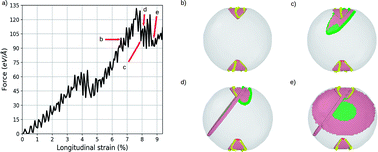On the mechanical response in nanoalloys: the case of NiCo†
Abstract
In this work, nanoindentation of spherical NiCo nanoalloys with core–shell and random mixing patterns was studied, and we compared them against monometallic nanoparticles in order to investigate how the mechanical response may be influenced by the elemental distribution and the proportion of each element. Independently of the mixing patterns, plasticity begins with the nucleation of Shockley partial dislocations (SPDs) at the nanoparticle surface, on several slip planes, which leads to the appearance of sessile dislocations and either a stacking fault pyramid (SFP) or an open pyramid at the poles of the spherical nanoalloys. SPDs leave behind stacking faults but, for core–shell structures, the formation of nanotwins was also observed. It was also found that the presence of Co in the external shell of the nanoparticle has the effect of raising the yield strength, which could be interpreted in terms of unstable stacking fault energy. These results have relevance in the design of nanoalloys, since elemental distribution and stoichiometry can be used to tune the desired mechanical properties of the nanoparticle.

- This article is part of the themed collection: Nanoalloys: recent developments and future perspectives


 Please wait while we load your content...
Please wait while we load your content...